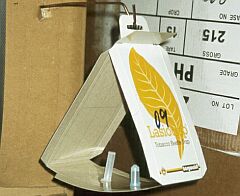The common packaging materials paper, cardboard and paperboard (corrugated board is the most susceptible) and most plastic films do not offer full protection against insect infestation. Previous test results have shown that hard PVC or thicker polyethylene films (PE films) are sufficiently resistant to insect attack.
Packaging materials can only be impregnated with insecticides in the case of industrial products (textiles); in the case of foodstuffs, food safety legislation must be complied with.
Insect-tight packaging should be used for transporting foodstuffs into the tropics, since massive insect infestation is a likely prospect.
Transport of goods infested with pests is only permitted if they are packed in such a way as to ensure that the pests do not migrate to uninfested goods. It is forbidden to transport infested goods in the same container as uninfested foodstuffs and semiluxury items.
Pest-free foodstuffs and semiluxury items must not be packed in containers which contain pests.
A container may be designated pest-free if no pests are to be found in the nooks and crannies accessible from the container and on the goods already packed.
The experience gained about the habits of storage pests has shown that the best conditions for storage (cool, dry and airy) are also the best when it comes to avoiding pest infestation.
Since, in practice, temperature regulation is not possible to the necessary extent, the main emphasis is on the second of these conditions:
It is imperative that goods are not stored in excessively damp surroundings.
Dry storage eliminates a number of troublesome pests (mites, European grain moth etc.) from the outset.
Order and cleanliness constitute the first principle of storage. Cargo residues must not be left in containers or warehouses.
 |
Figure 65: Trap used to identify pests; Photo: Schieder |
The following three groups of methods pest control will now be explained.
- Mechanical methods of control:
These include cleaning goods in storage areas and cleaning containers.
Traps are sometimes also used, for example to identify pest infestation of tobacco (see Fig. 65).
- Physical methods of control:
Pest infestation may be combated by cooling or heating, depending on the temperature requirements of the pests. The most effective method for killing pests is repeated raising (70°C) and lowering of the temperature. However, this method is not feasible in the case of container transport.
- Chemical methods of control:
These are currently the most important methods. The following insecticides are classified according to the manner in which they are assimilated by the pests:
- Stomach poisons
- Fumigants and
- Contact poisons (contact insecticides).
- Stomach poisons are of only subordinate importance. Bait laced with stomach poisons is harmful to humans.
- Fumigants are gaseous respiratory poisons which are breathed in. Fumigation is at present the most widespread method of pest control, since gases, such as phosphine (phosphorus hydride, PH3), hydrogen cyanide (HCN) and methyl bromide (CH3Br), are the most effective pesticides and leave the smallest quantities of toxic residues. To combat rats, fumigation with hydrogen cyanide is by far the most effective method.
using agents with a certain long-term effect, which present a toxic hazard to humans for a relatively long time, and using agents which have an immediate effect but which decompose or volatilize rapidly and lose their toxicity soon after use. Standard containers on long voyages merit particular attention.
Spray or fumigation agents have the following advantages and disadvantages with regard to use:
Dusting or spraying of insecticides into the cargo to be disinfested has the advantage of providing relatively long-term protection against new infestation; the disadvantage is the toxicity of these insecticides, which leave persistent residues in the cargo.
The advantage of pesticidal fumigation agents is that the gases are better distributed in the cargo stacks, so that hidden pests and pests in the various stages of development may be killed. Virtually no toxic residues remain in the cargo.
Fumigation agents should not be expected to be very effective at low temperatures, because the pests fall prey to low temperature torpidity and respiration is limited severely. It is therefore important for the temperature to be as high as possible during fumigation.
Fumigation with methyl bromide (CH3Br) against insect infestation in containers:
Methyl bromide is a low boiling gas (4.5°C), which consequently evaporates rapidly.
Containers which have been fumigated with methyl bromide must be labeled as such. Fumigation with methyl bromide is conventional in Europe and in the Far East. All fumigation contractors must be recognized and make out appropriate certificates after fumigation.
Fumigation takes three days:
| 1st day: | fumigation is performed |
| 2nd day: | the gas remains in the container |
| 3rd day: | container is opened, ventilation being effected passively by opening of the container doors. |
Contact insecticides have more recently achieved a certain significance. They kill the pests merely on contact. The outer skin of the insects consists of chitin, which forms a very thin layer on the joint membranes and at the sensory cells (feelers, legs, mouth parts), so allowing uptake of the poisons. Successful combating of pests with contact insecticides requires a knowledge of the pests' habitual pathways. These pathways are coated with the contact insecticide and finally the numerous dead insects are brushed away.